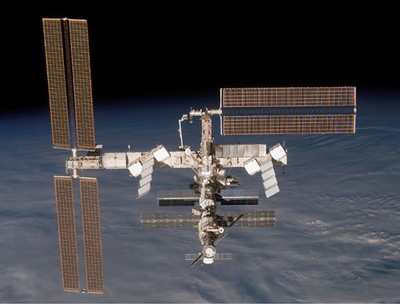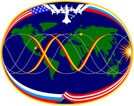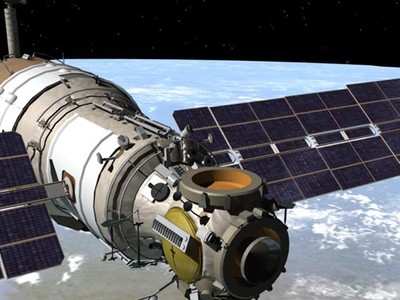Fire Zvezda Thrusters, Test In-Station "Satellites"
NASA tells ANN the Expedition 15 crew aboard the International
Space Station completed its first week of station orientation as
the crew worked with experiments and hardware maintenance.

Commander Fyodor Yurchikhin and flight engineers Oleg Kotov and
Suni Williams began the week with a couple light duty days after
the busy handover operations with the former crew. Expedition 14
Commander Michael Lopez-Alegria and Flight Engineer Mikhail Tyurin,
accompanied by Spaceflight Participant Charles Simonyi, returned to
Earth April 20, and are at the Gagarin Cosmonaut Training Center in
Star City, Russia, for several weeks of post mission debriefing and
rehabilitation.
Additionally this week, the station crew participated in several
drills to maintain medical and emergency proficiency skills.
Yurchikhin and Kotov began sessions throughout the first two weeks
of their residence to orient themselves with the station’s
operating systems. Williams, who served as an Expedition 14 crew
member, is aiding Expedition 15 with their station orientation.
As Aero-News reported, on
Thursday Williams was told she will return to Earth aboard space
shuttle Atlantis, targeted for launch June 8. That shuttle mission,
STS-117, will carry astronaut Clay Anderson to the station to join
Expedition 15 in progress. Their rotation was originally planned
for STS-118, targeted for launch August 8.
 NASA managers approved the crew
rotation after a more detailed review determined it would not
impact station operations or future shuttle mission objectives.
Since an earlier crew rotation was possible, they decided it would
be prudent to return Williams and deliver Anderson sooner rather
than later. Upon Williams' return, she will have accumulated more
time in space than any other woman.
NASA managers approved the crew
rotation after a more detailed review determined it would not
impact station operations or future shuttle mission objectives.
Since an earlier crew rotation was possible, they decided it would
be prudent to return Williams and deliver Anderson sooner rather
than later. Upon Williams' return, she will have accumulated more
time in space than any other woman.
Williams spent some of her off-duty time completing additional
test runs for the Capillary Flow Experiment. Capillary flow is the
key process used to move fluids in a microgravity environment. It
uses the low-gravity environment provided by the station to
understand the special dynamics of capillary flow and will aid in
the design of fluid transport systems on future spacecraft.
On Monday, Williams set up and activated cameras for the Earth
Knowledge Acquired by Middle School Students, or EarthKAM,
education experiment. Middle school students program a digital
camera on the station to photograph a variety of geographical
targets from the unique vantage point of space. Undergraduate teams
at the University of California at San Diego manage the images and
post them on the Web for the public and participating classrooms
around the world to view. Nearly 4,000 students from 66 schools in
seven countries are participating in this run.
On Friday, Williams performed a series of test flights with
small free-flying satellites for the Synchronized Position Hold,
Engage, Reorient, Experimental Satellites (SPHERES) experiment. The
experiment uses 8-inch diameter spherical satellites that fly
within the station cabin. The satellites test the basics of
formation flight and autonomous docking that could be used in
future spacecraft. The battery-powered satellites use carbon
dioxide to fuel 12 thrusters as they fly in the cabin.
In addition to general station orientation, Yurchikhin and Kotov
also performed maintenance work on life support hardware in the
Russian segment. The water separator in the air conditioning system
was replaced. The separator dispositions condensate water and air
collected from the station’s atmosphere that forms through
the air conditioner, maintaining optimum humidity levels
onboard.

Flight controllers and mission managers test fired the two main
engines on the Zvezda Service Module in a Wednesday reboost,
raising the station’s altitude. It was the first time the
engines had been fired since initial arrival of Zvezda in 2000.
Another reboost using ISS Progress 24 engines was scheduled for
Saturday, in order to finish placing the station in its correct
position for the arrival of the ISS Progress 25 cargo vehicle May
16 and the space shuttle Atlantis in June.
 ANN's Daily Aero-Term (04.20.24): Light Gun
ANN's Daily Aero-Term (04.20.24): Light Gun Aero-News: Quote of the Day (04.20.24)
Aero-News: Quote of the Day (04.20.24) ANN's Daily Aero-Linx (04.21.24)
ANN's Daily Aero-Linx (04.21.24) Aero-News: Quote of the Day (04.21.24)
Aero-News: Quote of the Day (04.21.24) ANN's Daily Aero-Term (04.21.24): Aircraft Conflict
ANN's Daily Aero-Term (04.21.24): Aircraft Conflict





